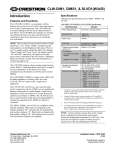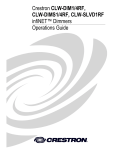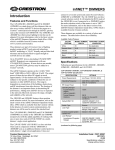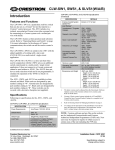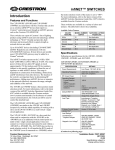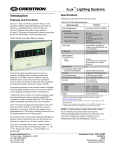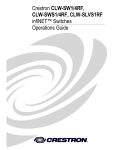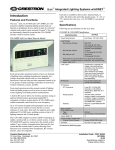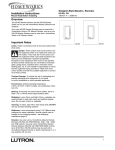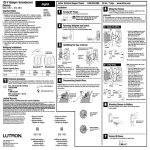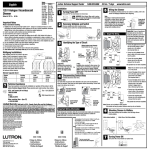Download Crestron CLW-DIMS1 Specifications
Transcript
CLW-DIM1, DIMS1, & SLVD1(W/A/B) Introduction Specifications Features and Functions Following are specifications for the -DIM1, -DIMS1, and -SLVD1. The CLW-DIM1 (-DIM1) is a stand-alone wall box dimmer that can also act as a Cresnet® device that reports to a Crestron® control processor. The CLW-DIM1 has two preset lighting levels that can be adjusted (refer to note below). The CLW-DIM1 also includes two isolated, non-polarized Cresnet wires (plus a ground wire) for connecting to the Cresnet network over a twisted pair wire with shield. CLW-DIM1, CLW-DIMS1, & CLW-SLVD1 Specifications SPECIFICATION NOTE: The two preset levels are noted as Preset 1-High and Preset 1- Low. “Preset 1-High” is usually used for turning lights on to full brightness while preset “Preset 1-Low” is usually used for turning the lights off. Although “Preset 1-High” and “Preset 1-Low” are usually used for “On” and “Off” respectively, the light level for each preset can be customized by the user. Refer to “Operation” on page 6 for more information on customizing light levels. Available Colors/Textures COLOR/ TEXTURE White MODEL NUMBER SUFFIX W MATCHING LUTRON FACEPLATE Not Applicable Smooth White W-S CW-1-WH Almond A CW-1-LA Smooth Almond A-S CW-1-LA Black B Not Applicable Smooth Black B-S CW-1-BL Crestron Electronics, Inc. 15 Volvo Drive Rockleigh, NJ 07647 Tel: 888.CRESTRON Fax: 201.767.7576 www.crestron.com Default Net ID -DIM1: 80 -DIMS1: 81 Switch Type Dimmer Load Type Incandescent, Tungsten-Halogen, Magnetic Low Voltage 2-Series Control System 1,2 Update File Version 3.117 or later 3 Incandescent/Tungsten Halogen Magnetic Low Voltage The CLW-DIMS1 (-DIMS1) is similar to the -DIM1 with the added capability of working with a slave unit (CLW-SLVD1) in a multi-dimmer / single circuit application. These dimmers are available in a variety of colors and textures. The table below shows the availability. Line Power, 120 VAC, 60 Hz Load Ratings The CLW-DIM1 features a three-position mode selection switch. Refer to “Operation” on page 6 for more information. In the absence of Cresnet communications, the dimmer can still be used to control lighting. The CLW-SLVD1 (-SLVD1) is a slave unit that when used in conjunction with the -DIMS1 acts as an additional dimmer control point in a multi-dimmer / single circuit application. It does not connect to a Cresnet system and cannot be used without a -DIMS1. The -SLVD1 does not have a mode selection switch and is not programmable. It emulates the operation of the -DIMS1 to which it is connected unless the mode selection switch of the master is set to “OFF”. DETAILS Power Requirements 4 -DIM1: 1000W -DIMS1: 1000W -SLVD1: N/A -DIM1: 1000VA/750W -DIMS1: 1000VA/750W -SLVD1: N/A Operating Temperature and Humidity 32°F to 104°F (0°C to 40°C) 10 to 90% Relative Humidity (Non-Condensing) Dimensions and Weight -DIM1 and -DIMS1: Height: 4.13 in (10.48 cm) Width: 2.38 in (6.03 cm) Depth: 1.91 in (4.85 cm) Weight: 4.9 oz (0.67 kg) -SLVD1: Height: 4.13 in (10.48 cm) Width: 1.75 in (4.45 cm) Depth: 1.91 in (4.85 cm) Weight: 3.6 oz (0.50 kg) 1. The latest software versions can be obtained from the Crestron website. Refer to the NOTE following these footnotes. 2. Crestron 2-Series control systems include the AV2 and PRO2. Consult the latest Crestron Product Catalog for a complete list of 2-Series control systems. 3. Refer to Derating Charts for Multigang Installations on page 4. 4. VA ratings are for input power to the transformer. If you do not know the input power requirement of the transformer, use the bulb’s wattage rating to determine proper rating. NOTE: Crestron software and any files on the website are for Authorized Crestron dealers and Crestron Authorized Independent Programmers (CAIP) only. New users may be required to register to obtain access to certain areas of the site (including the FTP site). Installation Guide – DOC. 6250B (2009754) 06.07 Specifications subject to change without notice. CLW-DIM1, DIMS1, & SLVD1(W/A/B) Physical Description The -DIM1 and -DIMS1 contain one large pushbutton, a light emitting diode (LED) with software adjustable brightness*, and a three-position slider-switch, shown after this paragraph. Line voltage connections are made at the rear of the dimmer. Three Class 2 low voltage wires, located on the front of the dimmer, provide a Cresnet connection to a control system. The wires can be routed to the bottom of the unit for placement outside of the wall box. The -SLVD1 is similar to the -DIM1 and -DIMS1 but does not have the slider-switch or the Class 2 low voltage wires. * Physical view of CLW-SLVD1 (clockwise from top; Top, Side, and Front) 1.91 in (4.85 cm) 1.75 in (4.45 cm) 3.81 in (9.68 cm) LED brightness can only be adjusted through Crestron programming software. 3.28 in (8.32 cm) CLW-DIM1/-DIMS1 (L) and CLW-SLVD1 (R) shown in white 2.70 in (6.86 cm) 4.13 in (10.48 cm) 1.50 in (3.81 cm) The -DIM1, -DIMS1, and -SLVD1 mount in a standard wallbox and are covered using a decorative faceplate (not included). Physical view of CLW-DIM1/-DIMS1 (clockwise from top; Top, Side, and Front) 1.75 in (4.45 cm) Industry Compliance This product is Listed to applicable UL Standards and requirements by Underwriters Laboratories Inc. E239011 2.38 in (6.03 cm) This device complies with part 15 of the FCC rules. Operation is subject to the following two conditions: (1) this device may not cause harmful interference, and (2) this device must accept any interference received, including interference that may cause undesired operation. 1.91 in (4.85 cm) 3.81 in (9.68 cm) 3.28 in (8.32 cm) 2.70 in (6.86 cm) 4.13 in (10.48 cm) 1.50 in (3.81 cm) CAUTION: Changes or modifications not expressly approved by the manufacturer responsible for compliance could void the user’s authority to operate the equipment. NOTE: This equipment has been tested and found to comply with the limits for a Class B digital device, pursuant to part 15 of the FCC Rules. These limits are designed to provide reasonable protection against harmful interference in a residential installation. This equipment generates, uses and can radiate radio frequency energy and, if not installed and used in accordance with the instructions, may cause harmful interference to radio communications. However, there is no guarantee that interference will not occur in a particular installation. If this equipment does cause harmful interference to radio or television reception, which can be determined by turning the equipment off and on, the user is encouraged to try to 2 • Stand Alone Wall Box Dimmer : CLW-DIM1, DIMS1, & SLVD1 Installation Guide – DOC. 6250B CLW-DIM1, DIMS1, & SLVD1(W/A/B) correct the interference by one or more of the following measures: recommends using 3 ½” deep wallboxes. Several devices can be installed in one wall box (multigang). This requires the removal of side sections (refer to diagram on page 4) and the derating of the dimming device. For a smooth appearance, one-piece multigang faceplates (not supplied) can be installed. Reorient or relocate the receiving antenna. Increase the separation between the equipment and receiver. Connect the equipment into an outlet on a circuit different from that to which the receiver is connected. • Other Switch Devices: Mechanical 3- or 4-way switches will not work with the -DIM1, -DIMS1, or -SLVD1. • Spacing: If mounting one device above another, leave at least 4 ½” vertical space between them. • Low Voltage Applications: Use with core and coil (magnetic) low voltage transformers only. Do not use any solid-state electronic low voltage transformers. Consult the dealer or an experienced radio/TV technician for help. Important Notes Read before installation. • Codes: Install in accordance with all local and national electrical codes. Alternate wiring methods may be used for the Class 2 wiring connection. The 2002 National Electrical Code (Article 725-55) prohibits Class 2 conductors of the -DIM1, -DIMS1, and -SLVD1 to occupy the same outlet box as the power conductors. The exception is Part D of Section 725.55 of the 2002 National Electrical Code, which allows a device’s power conductors to be installed near (0.25 inch minimum spacing) associated Class 2 conductors in the same outlet box. Consult the 2002 National Electrical Code Handbook and your local electrical inspector before proceeding. Do not use the supplied butt-splice connectors if the Class 2 conductors are to be installed in the wallbox with the power conductors. Use approved connectors (supplied by others) to make Class 2 connections inside the wallbox. • CAUTION: TO REDUCE THE RISK OF OVERHEATING AND POSSIBLE DAMAGE TO OTHER EQUIPMENT, DO NOT INSTALL TO CONTROL A RECEPTACLE OR A MOTOR OPERATED APPLIANCE (i.e. BATH FAN). • Wiring: Use copper wire only. For supply connections, use wires rated for at least 75°C. • Lamp Type: The -DIM1, -DIMS1, and -SLVD1 are designed for use with permanently installed incandescent, magnetic low voltage, or tungstenhalogen only. • Temperature: The -DIM1, -DIMS1, and -SLVD1 are designed to be used where temperatures are between 32° to 104°F (0° to 40°C). • Wallboxes: Devices mount in standard wallboxes. For easy installation, Crestron Installation Guide – DOC. 6250B Operation of a low voltage circuit with all lamps inoperative or removed may result in current flow in excess of normal levels. To avoid transformer overheating and premature transformer failure, Crestron recommends the following: Do not operate low voltage circuits without operative lamps in place. Replace burned-out lamps as quickly as possible. Use transformers that incorporate thermal protection or fuse transformer primary windings to prevent transformer failure due to overcurrent. Multigang Installations In multigang installations, several controls are grouped horizontally in one wallbox. For a smooth appearance, one-piece multigang faceplates (not supplied) can be installed. 1. When combining controls in a wallbox, remove inner side sections prior to wiring (refer to the following figure). Stand Alone Wall Box Dimmer: CLW-DIM1, DIMS1, & SLVD1 • 3 CLW-DIM1, DIMS1, & SLVD1(W/A/B) can be daisy chained, T-tapped, or home run back to the control system. Refer to the following wiring diagram. Inner Sections of Multiganged Switches REMOVE INNER SECTIONS Wiring Diagram of CLW device to Cresnet NOTE: The GRAY (Cresnet) wires are not polarized. These wires can be connected to either the Y or Z line on a Cresnet port. DO NOT REMOVE OUTER SECTIONS The load capacity must also be derated. The following charts provide derating information for various applications. Derating Information for Incandescent and Tungsten Halogen Applications Part Number No Side Removed One Side Removed Two Sides Removed -DIM1 1000W 600W 400W -DIMS1 1000W 600W 400W -SLVD1 No Derating Necessary Derating Information for Magnetic Low Voltage Applications* Part Number One Side Removed Two Sides Removed -DIM1 1000VA/750W 600VA/450W 400VA/300W -DIMS1 1000VA/750W 600VA/450W 400VA/300W -SLVD1 * No Side Removed No Derating Necessary VA ratings are for input power to the transformer. If you do not know the input power requirement of the transformer, use the bulb’s wattage rating to determine proper rating. 2. To remove a side section, bend the side section back and forth with a pair of pliers until the section breaks off from the mounting plate. Use a file or sandpaper to remove any excess metal. Prewire for Master Application Each device has two Class 2 low voltage wires (plus a ground wire) that provide a Cresnet connection over shielded twisted-pair to a Crestron control system. These wires are routed to the bottom of the device for connection outside of the wallbox. The low voltage wires are pulled from each device location to the Crestron control system or a Crestron connection block device. Use #22 AWG, twisted, shielded, 2-conductor wire. Wiring NOTE: The BLACK wire (Cresnet ground) should not be grounded with the GREEN (Ground) wire on the -DIM1/-DIMS1. NOTE: Crestron recommends using Cresnet-DM cable for connecting the -DIM1 and -DIMS1 to the Cresnet network. Installation WARNING: Turn off power at the circuit breaker. Installing with power on can result in serious personal injury and damage to the device. NOTE: The -DIM1, -DIMS1, and -SLVD1 require a neutral wire for operation. If no neutral is present, contact a licensed electrician for installation or refer to the alternative wiring diagrams described in “Appendix: Wiring Diagrams” on page 9. NOTE: The -DIMS1 must be installed in the same wallbox that contains the connections to the load. NOTE: New installations should be checked for short circuits prior to installing the -DIM1, -DIMS1, or -SLVD1. With power off, close the circuit and restore power. If the lights do not work or a breaker trips, check and correct the wiring or fixture (if necessary). Install the -DIM1, -DIMS1, or -SLVD1 only when the short is no longer present. The warranty is void if the -DIM1, -DIMS1, or -SLVD1 is installed and operated with a shorted load. When installing a -DIM1 or a -DIMS1 without a slave, follow the instructions in “Wiring a -DIM(S)1 (No Slaves)”. If wiring a -DIMS1 with a -SLVD1, refer to 4 • Stand Alone Wall Box Dimmer : CLW-DIM1, DIMS1, & SLVD1 Installation Guide – DOC. 6250B CLW-DIM1, DIMS1, & SLVD1(W/A/B) “Wiring a -DIMS1 with One or More -SLVD1s”. Wiring a -DIMS1 with One or More -SLVD1s Wiring a -DIM(S)1 (No Slaves) NOTE: The -DIMS1 must be installed in the same wallbox that contains the connections to the load. The following describes the installation of a stand-alone -DIM1 or -DIMS1. 1. Turn power off at the circuit breaker. 2. Pull Class 2 low voltage wires through a hole in the drywall located outside of the electrical box, to the Crestron control system or a Crestron connection block device. Leave wires outside of the wallbox for connection to the -DIM1 or -DIMS1. The following describes installation of a -DIMS1 master with a -SLVD1 slave. 1. Turn power off at the circuit breaker. 2. Pull Class 2 low voltage wires through a hole in the drywall located outside of the electrical box, to the Crestron control system or a Crestron connection block device. Leave wires outside of the wallbox for connection to the -DIM1 or -DIMS1. NOTE: Alternate wiring methods may be used for the Class 2 wiring connection. Refer to section 725-55, Part D of the 2002 National Electric Code. 3. NOTE: Alternate wiring methods may be used for the Class 2 wiring connection. Refer to section 725-55, Part D of the 2002 National Electric Code. Wire the dimmer as shown in Figure 1 on page 9. NOTE: The RED (Load) and BLACK (Hot) wires are #14 AWG. The BLUE (Slave) and WHITE (Neutral) wires are #18 AWG. The GREEN (Ground) wire is #16 AWG. The GRAY (Cresnet) wires are #22 AWG. The BLACK wire (Cresnet ground) paired with the GRAY (Cresnet) wires is #22 AWG. 3. NOTE: Do not connect the BLUE (Slave) wire to the Black (Hot) or RED (Load) wires. NOTE: The RED (Load) and BLACK (Hot) wires are #14 AWG. The BLUE (Slave) and WHITE (Neutral) wires are #18 AWG. The GREEN (Ground) wire is #16 AWG. The GRAY (Cresnet) wires are #22 AWG. The BLACK wire (Cresnet ground) paired with the GRAY (Cresnet) wires is #22 AWG. NOTE: Since the -DIMS1 is installed without a -SLVD1, the BLUE lead (Slave) should be capped. Alternative Wiring For situations where a neutral is not present or other scenarios that may be encountered during installation, refer to the “Stand-Alone Installations” section of “Appendix: Wiring Diagrams” on page 9. 4. NOTE: If a -DIMS1 is installed without a -SLVD1, the BLUE lead (Slave) should be capped. NOTE: The WHITE (Neutral) connection on the -SLVD1 is optional and is only required for operation of the LED. If the neutral is not available, the white lead should be capped off. Splice the gray wires of the -DIM1 or -DIMS1 to the Class 2 low voltage wires connected to the Crestron control system or a Crestron connection block device. Push the wires and the splices into a hole in the drywall to provide the necessary separation. 5. Push all power wires back into the wallbox and fasten the device to the wallbox with the provided screws. 6. Attach decorative faceplate. 7. Restore power at the circuit breaker. Installation Guide – DOC. 6250B Wire the dimmers as shown in Figure 4 on page 10. Alternative Wiring For situations where a neutral is not present or other scenarios that may be encountered during installation, refer to the “Master-Slave Installations” section of “Appendix: Wiring Diagrams” on page 10. 4. Splice the gray wires of the -DIMS1 to the Class 2 low voltage wires connected to the Crestron control system or a Crestron connection block device. Push the wires and the splices into a hole in the drywall to provide the necessary separation. Stand Alone Wall Box Dimmer: CLW-DIM1, DIMS1, & SLVD1 • 5 CLW-DIM1, DIMS1, & SLVD1(W/A/B) 5. Push all power wires back into the wallbox and fasten the devices to their respective wallboxes with the provided screws. 6. Attach decorative faceplates. 7. Restore power at the circuit breaker. Operation The -DIM1, -DIMS1, and -SLVD1 have one large pushbutton. The -DIM1 and -DIMS1 also have a threeposition mode selection switch. The function of the pushbutton is determined by the position of the mode selection switch. Refer to the following diagram. NOTE: The -SLVD1 does not have a mode selection switch. It emulates the operation of the -DIMS1 to which it is connected unless the mode selection switch of the master is set to “OFF”. Buttons of CLW-DIM1, -DIMS1, and -SLVD1 Button Mode Selection Switch (-DIM1 & -DIMS1 Only) OFF When the mode selection switch is in the “OFF” position, the pushbutton will not have any function and the load is disconnected from the power source. This must be used when changing light bulbs to ensure that the load is fully disconnected from power. ADJ When the mode selection switch is in the “ADJ” position, the pushbutton is used to switch between the “Preset 1High” and “Preset 1-Low” presets (typically “On” and “Off”) as well as adjust the lighting level. Tap the pushbutton to fade up or down to either of the two preset lighting levels. Tap the pushbutton while the lighting level is fading to jump directly to the preset lighting level without fading. (i.e., tapping while the lighting level is fading up will jump to the “Preset 1-High” level without fading, tapping while the lighting level is fading down will jump to the “Preset 1-Low” level without fading). While the light is off, double-tap the pushbutton to jump directly to the “Preset 1-High” lighting level without fading. ramp up or down. The lighting level will stop at maximum brightness (100%) if the lighting level was ramping up or minimum brightness (0%) if the lighting level was ramping down. To continue ramping the lighting level in the opposite direction, release the pushbutton, then press and hold the pushbutton again. When the desired lighting level is reached, release the pushbutton. If the lighting level is to be stored as a preset, move the mode selection switch to the PRE position. Press and hold the pushbutton until the LED flashes. PRE NOTE: Before storing a preset, the lighting must be adjusted to the desired level while in the ADJ mode. When the switch is in the PRE position, it is in the preset mode and can be used to recall and/or store preset lighting levels. The pushbutton is used to recall and/or store the “Preset 1-High” and “Preset 1-Low” presets. Pressing and releasing the pushbutton will fade to the preset lighting level over a preset amount of time*. Tapping the pushbutton while the light is fading will cause the light level to “jump” directly to the preset without fading. Pressing and holding the pushbutton until the LED flashes will store the current lighting level. * The preset fade time can only be adjusted through Crestron programming software. To store preset values for “Preset 1-High” and “Preset 1Low”; while in the PRE mode, recall the lighting level to be changed. Switch to the ADJ mode and adjust the lighting to the desired level. Move the mode selection switch to PRE. Press and hold the pushbutton until the LED flashes to store the new preset value. NOTE: If a new preset value for “Preset 1-High” is lower than the stored value for “Preset 1-Low”, the previously stored value for “Preset 1-Low” becomes “Preset 1-High”. Similarly, if a new preset value for “Preset 1-low” is higher than the value stored for “Preset 1-High”, the previously stored value for “Preset 1-High” becomes “Preset 1-Low”. NOTE: The default preset light values for each preset are: • Preset 1-High: 100% • Preset 1-Low: 0% NOTE: The device may be warm to the touch during operation. This is normal. The lighting level can be adjusted by pressing and holding the pushbutton. After a ½ second, the lighting level will 6 • Stand Alone Wall Box Dimmer : CLW-DIM1, DIMS1, & SLVD1 Installation Guide – DOC. 6250B CLW-DIM1, DIMS1, & SLVD1(W/A/B) Restoring Default Settings SIMPL Windows To restore the dimmer’s default settings for lighting levels, preset fade time (two seconds), and ramp time (five seconds), move the mode selection switch to the PRE position. While holding the pushbutton, move the mode selection switch to the ADJ position and back to the PRE position. Release the pushbutton. The LED will flash to confirm that the default values have been restored. SIMPL Windows is Crestron’s premier software for programming Crestron control systems. NOTE: While SIMPL Windows can be used to program the CLW-DIM1, it is recommended to use D3 Pro for configuring a Crestron lighting system. • In Configuration Manager, incorporate a CLW-DIM1 into the system by dragging the CLW-DIM1 from the Lighting | Wall Dimmers/Switches (Cresnet CLW Series) folder of the Device Library and dropping it in the System Views. Double click a device to open the “Device Settings” window and change the Net ID if required. The ID code specified in the SIMPL Windows program must match the Net ID of each unit. • In Programming Manager, assign signal names to program the CLW-DIM1 to operate with the control system. Setup & Programming Required Software Software TASK Program control system to operate CLW-DIM1. REQUIRED SOFTWARE VERSION ® SIMPL™ Windows version 2.07.32 or later with SIMPL+ Cross Compiler version 1.1 or later and Library update 387 or later; Also requires Crestron Database version 18.1.5 or later. Upload program and firmware. Crestron Toolbox 1.02.29 or later. Program with simple wizards for lighting systems using a CLW-DIM1 (optional but recommended). Crestron D3 Pro™ version 2.1.7 or later with D3 Pro Templates version 2.0.1 or later. Refer to software release notes or Crestron website for other required Crestron software packages. For additional details, download SIMPL Windows from the Crestron website and examine the extensive help file. Setup The Net ID of the CLW-DIM1 has been factory set to 80. The Net IDs of multiple CLW-DIM1 devices in the same system must be unique. Net IDs are changed from a personal computer (PC) via the Crestron Toolbox. When setting the Net ID, the Net ID of each unit must match an ID code specified in the SIMPL Windows program. For more details, refer to the Crestron Toolbox help file. D3 Pro Crestron D3 Pro Software provides all the tools necessary to create a complete Crestron Lighting System for residential applications. The lighting system includes the control system program, touchpanel screens and keypad programming, documentation, and real-time lighting adjustment capabilities. As with all Crestron software, the D3 Pro software provides extensive right-click and dragand-drop functionality, in addition to convenient keyboard shortcuts for frequently used functions and commands. For additional details, download D3 Pro from the Crestron website and examine the extensive help file. Installation Guide – DOC. 6250B Stand Alone Wall Box Dimmer: CLW-DIM1, DIMS1, & SLVD1 • 7 CLW-DIM1, DIMS1, & SLVD1(W/A/B) Problem Solving Return and Warranty Policies Troubleshooting Merchandise Returns / Repair Service The table after this paragraph provides corrective action for possible trouble situations. If further assistance is required, please contact a Crestron customer service representative. 1. No merchandise may be returned for credit, exchange or service without prior authorization from CRESTRON. To obtain warranty service for CRESTRON products, contact an authorized CRESTRON dealer. Only authorized CRESTRON dealers may contact the factory and request an RMA (Return Merchandise Authorization) number. Enclose a note specifying the nature of the problem, name and phone number of contact person, RMA number and return address. 2. Products may be returned for credit, exchange or service with a CRESTRON Return Merchandise Authorization (RMA) number. Authorized returns must be shipped freight prepaid to CRESTRON, 6 Volvo Drive, Rockleigh, N.J. or its authorized subsidiaries, with RMA number clearly marked on the outside of all cartons. Shipments arriving freight collect or without an RMA number shall be subject to refusal. CRESTRON reserves the right in its sole and absolute discretion to charge a 15% restocking fee plus shipping costs on any products returned with an RMA. 3. Return freight charges following repair of items under warranty shall be paid by CRESTRON, shipping by standard ground carrier. In the event repairs are found to be nonwarranty, return freight costs shall be paid by the purchaser. Dimmer Troubleshooting TROUBLE Dimmer does not function. POSSIBLE CAUSE(S) CORRECTIVE ACTION Dimmer is not receiving line power. Verify that the dimmer is properly connected to power line and that the circuit breaker is closed. Load is not connected. Verify that load is operational and that the mode selection switch is in the PRE position. If the dimmer does not function after performing the above corrective actions, restore the dimmer’s default settings by moving the mode selection switch to the “PRE” position. While holding the pushbutton, move the mode selection switch to the “ADJ” position and back to the “PRE” position. Release the pushbutton. The LED will flash once to confirm that the default values have been restored. Further Inquiries If you cannot locate specific information or have questions after reviewing this guide, please take advantage of Crestron's award winning customer service team by calling the Crestron corporate headquarters at 1-888-CRESTRON [1-888-273-7876]. For assistance in your local time zone, refer to the Crestron website (http://www.crestron.com/offices) for a listing of Crestron worldwide offices. You can also log onto the online help section of the Crestron website (http://www.crestron.com/onlinehelp) to ask questions about Crestron products. First-time users will need to establish a user account to fully benefit from all available features. Future Updates As Crestron improves functions, adds new features, and extends the capabilities of the device, additional information may be made available as manual updates. These updates are solely electronic and serve as intermediary supplements prior to the release of a complete technical documentation revision. Check the Crestron website periodically for manual update availability and its relevance. Updates are identified as an “Addendum” in the Download column. CRESTRON Limited Warranty CRESTRON ELECTRONICS, Inc. warrants its products to be free from manufacturing defects in materials and workmanship under normal use for a period of three (3) years from the date of purchase from CRESTRON, with the following exceptions: disk drives and any other moving or rotating mechanical parts, pan/tilt heads and power supplies are covered for a period of one (1) year; touchscreen display and overlay components are covered for 90 days; batteries and incandescent lamps are not covered. This warranty extends to products purchased directly from CRESTRON or an authorized CRESTRON dealer. Purchasers should inquire of the dealer regarding the nature and extent of the dealer's warranty, if any. CRESTRON shall not be liable to honor the terms of this warranty if the product has been used in any application other than that for which it was intended or if it has been subjected to misuse, accidental damage, modification or improper installation procedures. Furthermore, this warranty does not cover any product that has had the serial number altered, defaced or removed. This warranty shall be the sole and exclusive remedy to the original purchaser. In no event shall CRESTRON be liable for incidental or consequential damages of any kind (property or economic damages inclusive) arising from the sale or use of this equipment. CRESTRON is not liable for any claim made by a third party or made by the purchaser for a third party. CRESTRON shall, at its option, repair or replace any product found defective, without charge for parts or labor. Repaired or replaced equipment and parts supplied under this warranty shall be covered only by the unexpired portion of the warranty. Except as expressly set forth in this warranty, CRESTRON makes no other warranties, expressed or implied, nor authorizes any other party to offer any warranty, including any implied warranties of merchantability or fitness for a particular purpose. Any implied warranties that may be imposed by law are limited to the terms of this limited warranty. This warranty statement supersedes all previous warranties. Trademark Information All brand names, product names and trademarks are the sole property of their respective owners. Windows is a registered trademark of Microsoft Corporation. Windows95/98/Me/XP/Vista and WindowsNT/2000 are trademarks of Microsoft Corporation. 8 • Stand Alone Wall Box Dimmer : CLW-DIM1, DIMS1, & SLVD1 Installation Guide – DOC. 6250B CLW-DIM1, DIMS1, & SLVD1(W/A/B) Appendix: Wiring Diagrams Following are wiring diagrams for circuits that may be found when installing a dimmer: Stand-Alone Installations Figure 1: Wiring a CLW-DIM(S)1 • Since a -DIMS1 is installed without a slave, the blue lead of the -DIMS1 must be capped. If a neutral is not present in the wallbox, the wiring shown in the following diagram can be used. Figure 2: Alternative Wiring of -DIM1 and -DIMS1 Where Neutral is Not Present (Load-Fed Switch Loop) In the above configuration: • The white wire from the -DIMS1 to the load is coded HOT. • Since a -DIMS1 is installed without a slave, the blue lead of the -DIMS1 must be capped. • The minimum load requirement is 100W. • Bulb noise may be present even when the load is off. • Circuits with small magnetic low-voltage loads may not work. 9 • Stand Alone Wall Box Dimmer: CLW-DIM1, DIMS1, & SLVD Installation Guide – DOC. 6250B CLW-DIM1, DIMS1, & SLVD1(W/A/B) To continue a circuit past a switched light fixture to one or more duplex receptacles, connect the dimmer as shown in the following diagram. Figure 3: Adding a Duplex Receptacle Past a Switched Light Fixture Master-Slave Installations Figure 4: Wiring a -DIMS1 with a -SLVD1 If a neutral is not present in the wallbox, the wiring methods shown in the following diagrams can be used when wiring a -DIMSX with -SLVD1 devices. Figure 5: Alternative Wiring of -DIMS1 with -SLVD1s Where Neutral is Not Present (End-Fed three-way system) In this configuration: • The white wire from the -DIMS1 to the load is coded HOT. 10 • Stand Alone Wall Box Dimmer : CLW-DIM1, DIMS1, & SLVD1 Installation Guide – DOC. 6250B CLW-DIM1, DIMS1, & SLVD1(W/A/B) • The white wire of the -SLVD1 must be capped. • The white line between -DIMS1 and the -SLVD must be capped on both ends. • The minimum load requirement is 100W. • Bulb noise may be present even when the load is off. • The LED on an attached -SLVD1 slave unit will not function. • Circuits with small magnetic low-voltage loads may not work. Figure 6: Alternative Wiring of -DIMS1 with -SLVD1 Where Neutral is Not Present (Center-Fed three-way system) In the above configuration: • The white wire from the -DIMS1 to the load is coded HOT. • The minimum load requirement is 100W. • Bulb noise may be present even when the load is off. • Circuits with small magnetic low-voltage loads may not work. Installation Guide – DOC. 6250B Stand Alone Wall Box Dimmer: CLW-DIM1, DIMS1, & SLVD1 • 11 CLW-DIM1, DIMS1, & SLVD1(W/A/B) This page is intentionally left blank. 12 • Stand Alone Wall Box Dimmer : CLW-DIM1, DIMS1, & SLVD1 Installation Guide – DOC. 6250B












